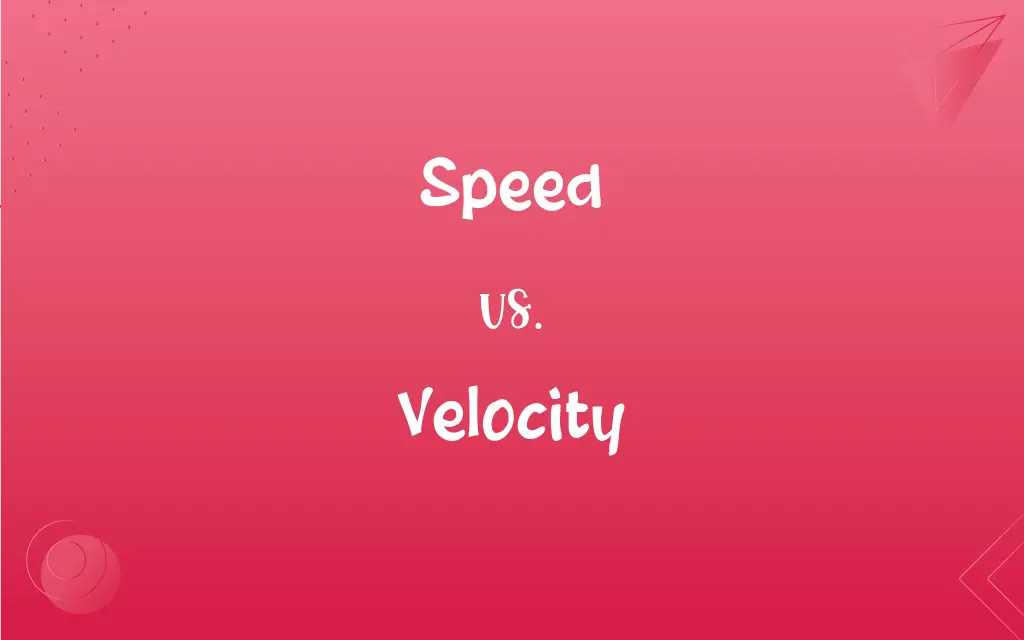Speed vs. Velocity: What's the Difference?
Edited by Aimie Carlson || By Harlon Moss || Updated on October 22, 2023
Speed is the rate of motion without direction, while velocity includes both speed and direction.

Key Differences
Speed is a scalar quantity that describes how fast an object is moving without any reference to direction. It's the magnitude of the motion. Velocity, on the other hand, is a vector quantity that tells us the rate of change of an object's position with respect to time, considering its direction.
While speed gives us an idea of how fast something is moving, it doesn't give us the full picture of its motion. Velocity, by taking into account the direction, provides a more comprehensive description. For instance, two cars moving at the same speed but in opposite directions have different velocities.
It's essential to recognize that even if two objects have the same speed, their velocities might differ. This difference arises from the directional component of velocity. If the two objects are moving in different directions, their velocities will not be the same.
Mathematically, speed is the magnitude of velocity. This means that speed is always a non-negative value, while velocity can have a positive or negative value depending on direction. For example, in a straight line motion, a positive velocity might indicate movement to the right, while a negative velocity indicates movement to the left.
Understanding the distinction between speed and velocity is crucial in physics. Speed might tell you how fast an object is going, but velocity will give you a fuller understanding of its motion, considering both magnitude and direction.
ADVERTISEMENT
Comparison Chart
Nature
Scalar
Vector
Definition
Rate of motion
Rate of motion with direction
Mathematical Aspect
Magnitude of velocity
Speed with direction
Values
Always non-negative
Can be positive, negative, or zero
Example
60 mph
60 mph eastward
ADVERTISEMENT
Speed and Velocity Definitions
Speed
Rate of movement or action.
The speed of the train was impressive.
Velocity
A vector measure of the rate of movement.
The velocity of the river current affected the boat's direction.
Speed
Distance covered per unit of time.
The speed of the car reached 100 miles per hour.
Velocity
Speed with a directional component.
The rocket's velocity pointed towards the outer space.
Speed
The magnitude of a velocity irrespective of direction.
Regardless of its direction, the ball's speed remained constant.
Velocity
The derivative of position with respect to time.
In physics, velocity is often derived from position-time graphs.
Speed
How fast something moves or happens.
The speed of the internet connection is vital for online gaming.
Velocity
Rate of change of position with respect to time.
The particle's velocity was constant in the magnetic field.
Speed
Quickness or swiftness.
He finished the task with incredible speed.
Velocity
Speed in a given direction.
The velocity of the wind shifted to the north.
Speed
Distance traveled divided by the time of travel.
Velocity
Rapidity or speed of motion; swiftness.
FAQs
Does velocity always consider direction?
Yes, velocity always includes a directional component.
What determines the magnitude of velocity?
The speed determines the magnitude of velocity.
How does one determine the direction of velocity?
The direction of velocity is determined by the movement of the object and is typically stated with the magnitude.
Are both speed and velocity measures of motion?
Yes, both speed and velocity measure motion, but velocity also considers direction.
Can an object have a high speed but zero velocity?
No, if an object has a high speed, its velocity cannot be zero.
In which field of study are speed and velocity crucial concepts?
Speed and velocity are fundamental concepts in physics.
If an object's speed remains constant, can its velocity change?
Yes, if the object changes direction, its velocity changes even if its speed remains constant.
If two objects move with the same speed but opposite directions, do they have the same velocity?
No, their velocities will differ because of the different directions.
If something has a velocity of zero, what is its speed?
Its speed would also be zero.
How do you calculate average speed?
Average speed is calculated as the total distance traveled divided by the total time taken.
How is velocity represented in equations?
Velocity is often represented by the letter 'v' in equations.
Is speed a vector or scalar?
Speed is a scalar quantity.
If a car is moving in a circle at a constant speed, is its velocity constant?
No, its velocity is not constant because the direction is continuously changing.
Is the formula for speed the same as that for magnitude of velocity?
Yes, the formula for speed (distance/time) is the same as that for the magnitude of velocity.
Can speed ever be negative?
No, speed is always non-negative, while velocity can be negative based on direction.
Can an object have varying speed but constant velocity?
No, if the speed varies, the magnitude of the velocity also changes.
How do speed and velocity relate to acceleration?
Acceleration is the rate of change of velocity. A change in speed or direction results in acceleration.
What does a negative velocity indicate?
A negative velocity indicates movement in the opposite reference direction.
Do speedometers in cars show speed or velocity?
Speedometers in cars show speed, not velocity.
About Author
Written by
Harlon MossHarlon is a seasoned quality moderator and accomplished content writer for Difference Wiki. An alumnus of the prestigious University of California, he earned his degree in Computer Science. Leveraging his academic background, Harlon brings a meticulous and informed perspective to his work, ensuring content accuracy and excellence.
Edited by
Aimie CarlsonAimie Carlson, holding a master's degree in English literature, is a fervent English language enthusiast. She lends her writing talents to Difference Wiki, a prominent website that specializes in comparisons, offering readers insightful analyses that both captivate and inform.































































